Campbell Clan Tartan: A Tapestry of History and Heritage
by Teresa Finn on Aug 01, 2024
Table of Content
The Campbell Clan, a prominent force in Scottish history, has left an enduring legacy woven into Scotland’s identity. Among the symbols of their rich heritage, the Campbell Clan Tartan stands out as a vibrant testament to their lineage, resilience, and strength. This article explores the intricate world of the Campbell Clan Tartan, examining its historical origins, evolution, and cultural significance.
Introduction
The Campbells, often called "The Kingmakers", emerged from the mists of time in the 11th century, establishing dominance over a vast swathe of Argyllshire in Western Scotland. Their rise to power was remarkable, with influence extending far beyond their ancestral lands, shaping Scotland's political and social dynamics for centuries. With its distinctive checkered pattern, the Campbell Clan Tartan became an inseparable part of their identity - a visual representation of their lineage and a symbol of their enduring legacy.
History of the Campbell Clan Tartan
Origins and Early Records
The origins of the Campbell Clan Tartan are steeped in mystery, much like the early history of the clan itself. While specific references to the Campbell Clan Tartan in early historical documents are scarce, evidence suggests that in their most basic forms, tartans date back to the ancient Celts. These early designs were not merely decorative; they served practical purposes such as camouflage and identification among different clans.
Historical Context
The Campbell Tartan, synonymous with the Black Watch, is more than a mere pattern; it symbolizes the clan's martial tradition and its impact on Scottish military history. The Black Watch regiment was formed to patrol the Highlands and ensure peace following the turbulent Jacobite rebellion of 1715. The tartan, adopted as the regiment's official design, symbolized the regiment's bravery and dedication. The significant presence of Campbells in the regiment underscores the clan's commitment to maintaining regional order and stability.
Evolution Over Time
The design of the Campbell Clan Tartan has undergone significant changes over the centuries, influenced by various factors such as fashion trends, the incorporation of new dyes, and the desire to differentiate the tartans of different clan branches. In its earliest forms, the Campbell clan plaid likely featured simple patterns of stripes and checks, using natural dyes derived from plants and minerals.
As the clan's influence grew, so did the complexity of the tartan's design. The introduction of synthetic dyes in the 19th century allowed for a broader range of colors and more intricate patterns, resulting in the vibrant and elaborate designs that characterize the Tartan Campbell Clan today. This evolution reflects the changing tastes of the time and the clan's adaptability and resilience in the face of shifting societal norms.
Throughout the years, the Campbell Clan Tartan has remained a living symbol of the clan's heritage, evolving while retaining its core elements. Each iteration tells a story of the clan's journey through history, encapsulating the spirit of the Campbells and their enduring connection to Scotland.
The Campbell Family Tartan Design
Key Elements and Colors
The Campbell Clan Tartan, commonly known as the Campbell of Argyll Tartan, is a striking design characterized by its bold use of contrasting colors and symmetrical patterns. At first glance, one is immediately drawn to the vibrant tapestry of deep green, blue, and red, interwoven with thin white stripes that create a distinctive checkered effect.
Green: Often referred to as Hunter's Green, this color symbolizes the rugged beauty and abundance of the Scottish Highlands - the natural realm that the Campbells called home. It evokes images of lush landscapes and rolling hills, reflecting the clan's deep-rooted connection to the land.
Blue: Interpreted as the color of loyalty and fidelity, blue embodies the Campbells' unwavering dedication to their clan and commitment to Scotland.
Red: Representing courage and strength, red speaks to the Campbells' prowess in battle and their enduring resilience throughout history.
White: The white stripes weaving through the tapestry of colors represent purity and integrity - symbols of the Campbells' adherence to honor and unwavering commitment to justice.
Together, these colors and patterns create a harmonious design that resonates with the values and traditions of the Campbell Clan.

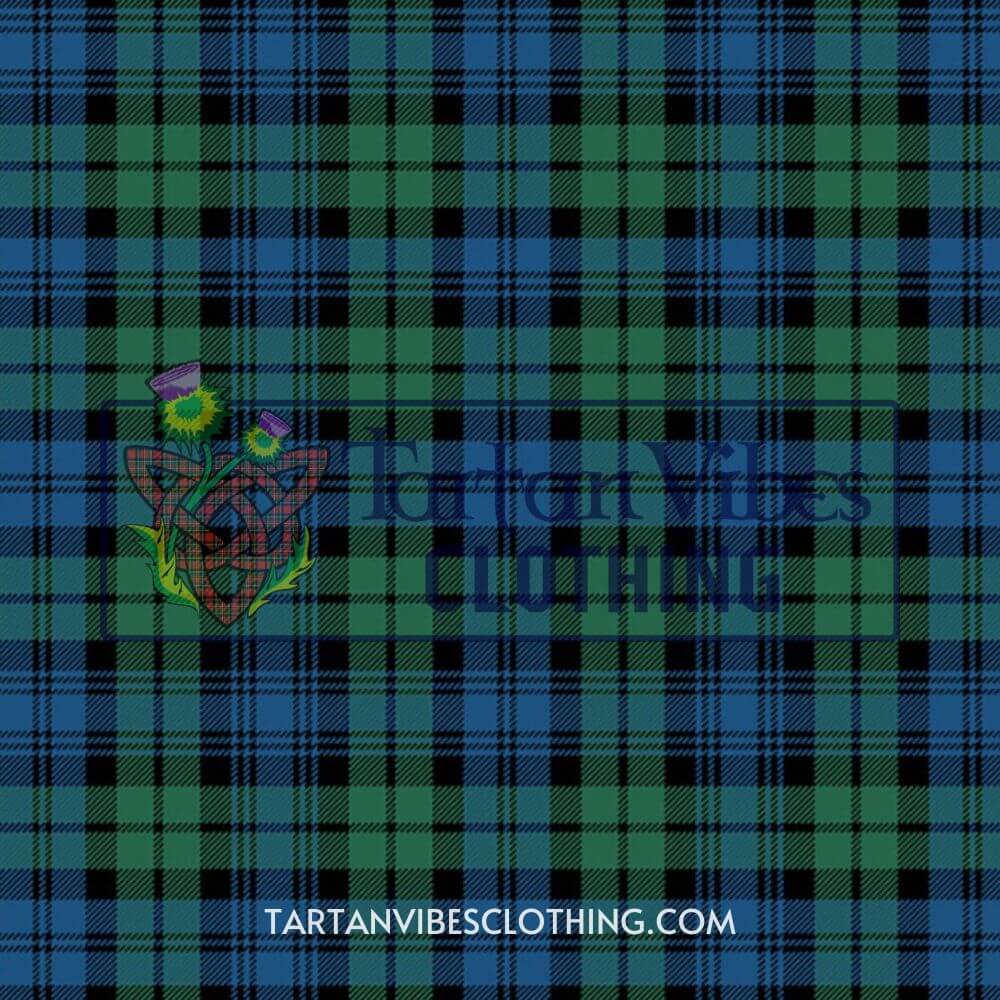
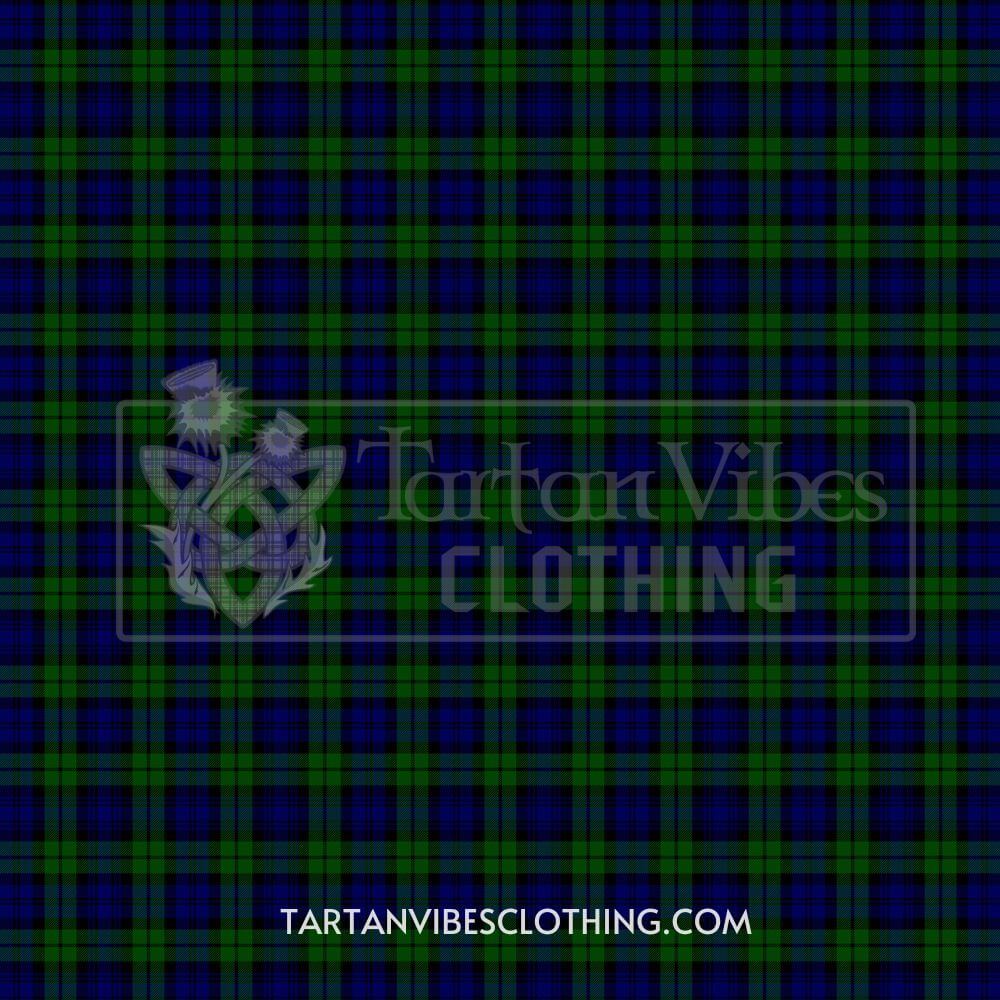


Traditional vs. Modern Designs
The Campbell Clan Tartan has been documented in various forms, reflecting the changing dynamics of weaving techniques and design preferences throughout history. The Ancient Campbell Tartan, often called the Weathered Campbell Tartan, captures the essence of the original tartan design. Characterized by muted colors and a more subtle checkerboard pattern, this version pays homage to the clan's early roots and the simplicity of traditional craftsmanship.
In contrast, the Modern Campbell Tartan features brighter, more saturated colors and a bolder checkerboard pattern. This contemporary interpretation reflects the evolution of weaving practices and the introduction of synthetic dyes, resulting in a visually striking tartan that is deeply connected to the clan's heritage. Today, the modern Campbell Clan Tartan remains popular, appearing on clan campbell tartan kilts, clothing, and various household items, allowing individuals to express their connection to the clan in diverse ways.
Whether worn in its ancient form or as a modern adaptation, the Campbell Clan Tartan symbolizes belonging and pride for its wearers.
Different Variations of Campbell Tartans
Campbell of Argyll Tartan
The Campbell of Argyll Tartan is perhaps the most widely recognized of all Campbell Clan tartans and is often considered the clan's official tartan. It is characterized by its bold and harmonious use of colors: Hunter's Green, navy blue, black, and white. These colors create a vibrant and distinctive checkered pattern that resonates with the clan's identity and symbolizes its historical ties to the Argyll region.
Design and Colors: The Argyll Tartan features a balanced arrangement of green and blue, interwoven with black and white stripes. The green is often seen as a representation of the lush landscapes of Argyll. At the same time, the blue signifies loyalty and tradition. The white stripes add a touch of elegance, completing the classic design.
Cultural Significance: This tartan symbolizes the clan's ancestral seat in Argyll, reflecting Campbell's enduring influence and connection to their historic lands. As the primary tartan for ceremonial occasions and clan gatherings, the Argyll Tartan is worn with pride by Campbells worldwide.




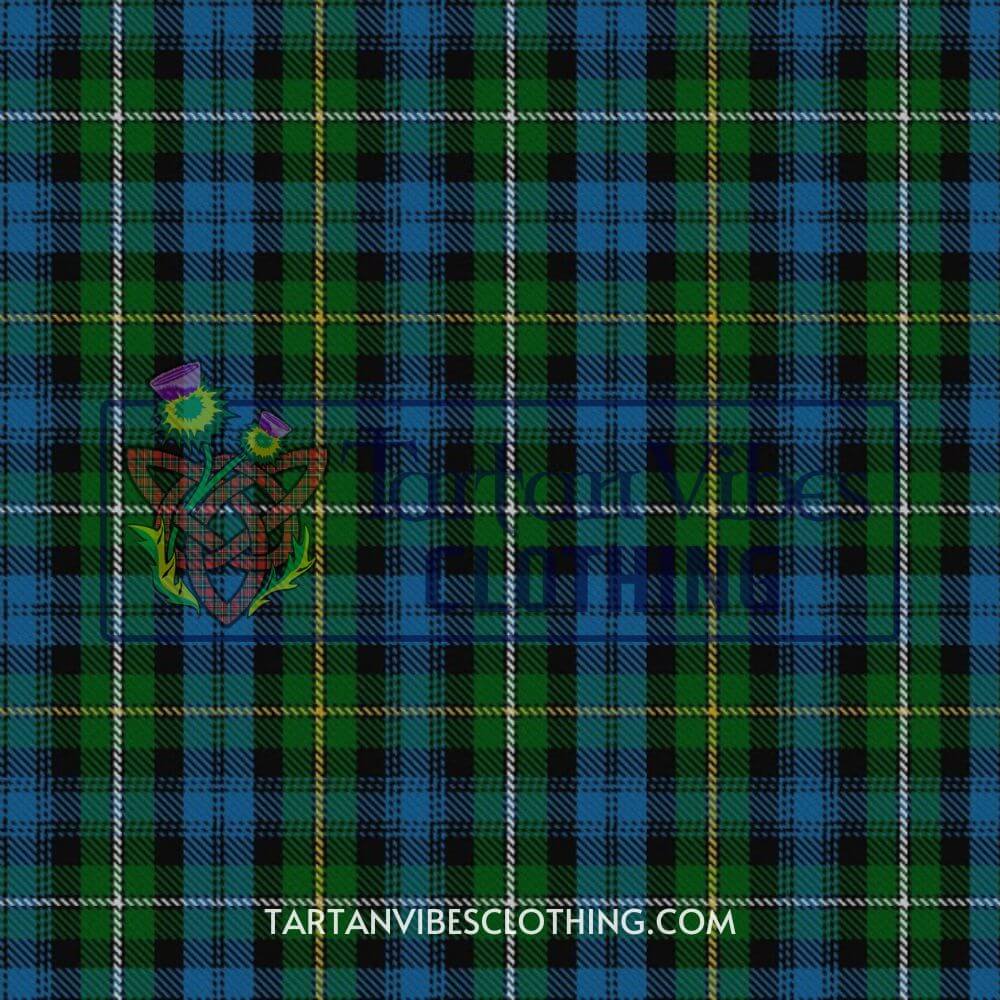
Explore the timeless traditions of the Clan Campbell of Argyll Tartan through our collection of tartan products on our website. And bring a piece of the clan's history into your present. 🔥
Campbell of Breadalbane Tartan
The Campbell of Breadalbane Tartan is associated explicitly with the Breadalbane or Glenorchy branches of Clan Campbell. This tartan is known for its more subdued and subtle checkerboard pattern, featuring navy blue, green, black, and yellow. Including yellow stripes sets it apart from the standard Campbell tartan, adding a touch of brightness and distinction.
Design and History: The Breadalbane Tartan is based on the traditional Clan Campbell Tartan but adds a layer of uniqueness with its yellow accents. The tartan first appeared in records in 1810, making it one of the earliest recorded designs attributed explicitly to the Breadalbane branch.
Cultural Importance: This tartan symbolizes the unique history and character of the Breadalbane Campbells, known for their strategic alliances and influence in the region. The addition of yellow to the traditional Campbell palette signifies this branch's vibrant and distinct nature.
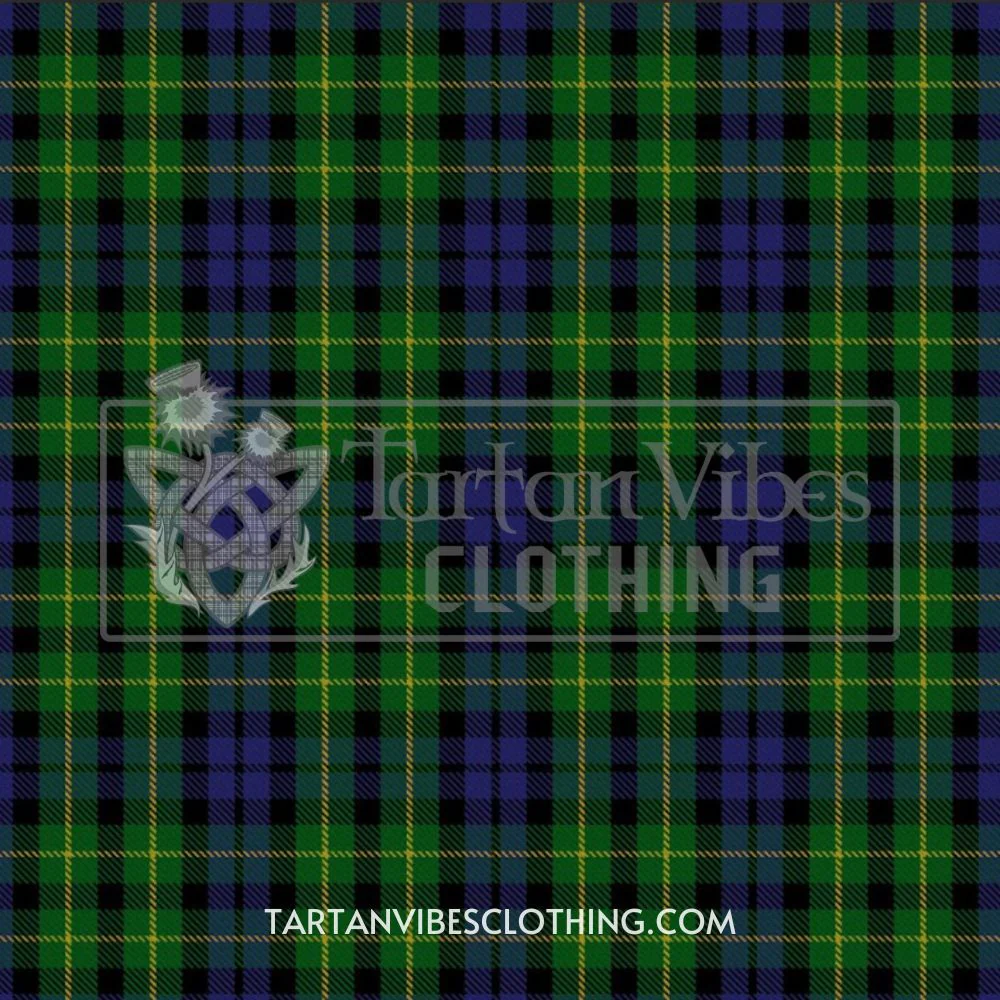
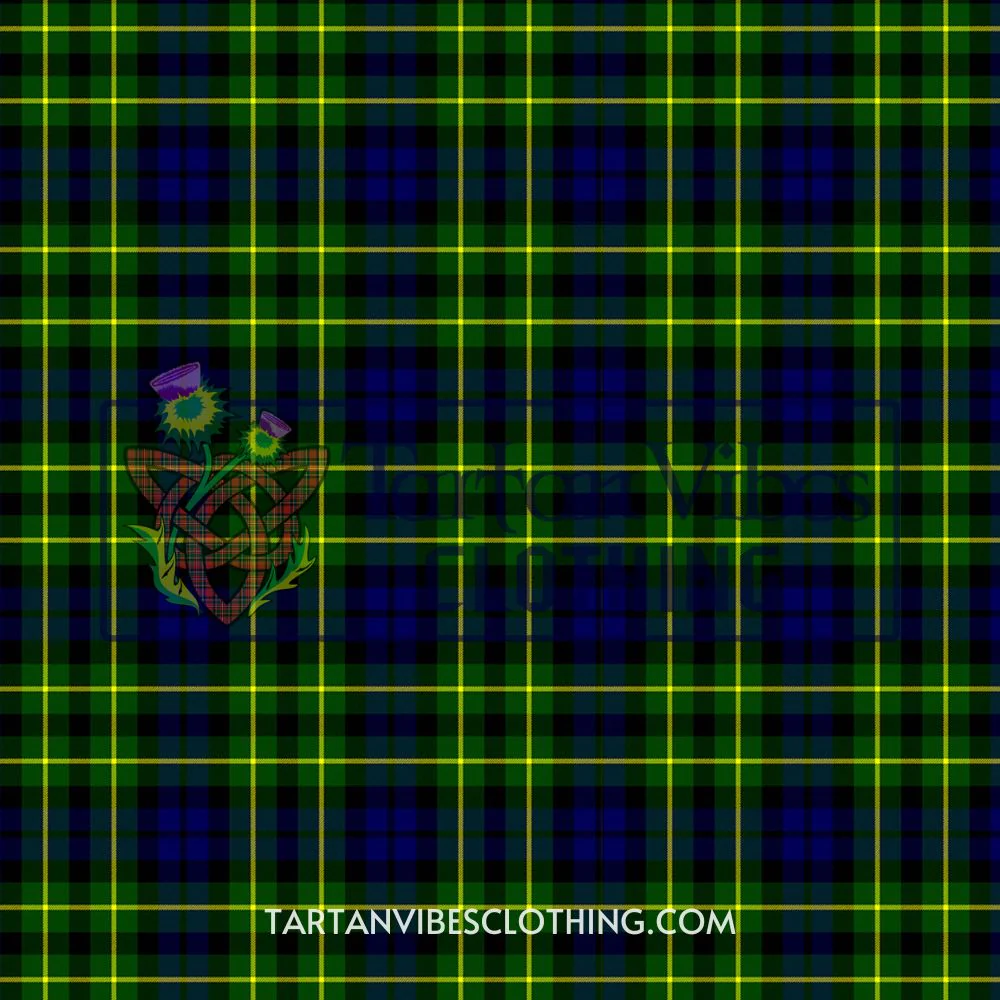
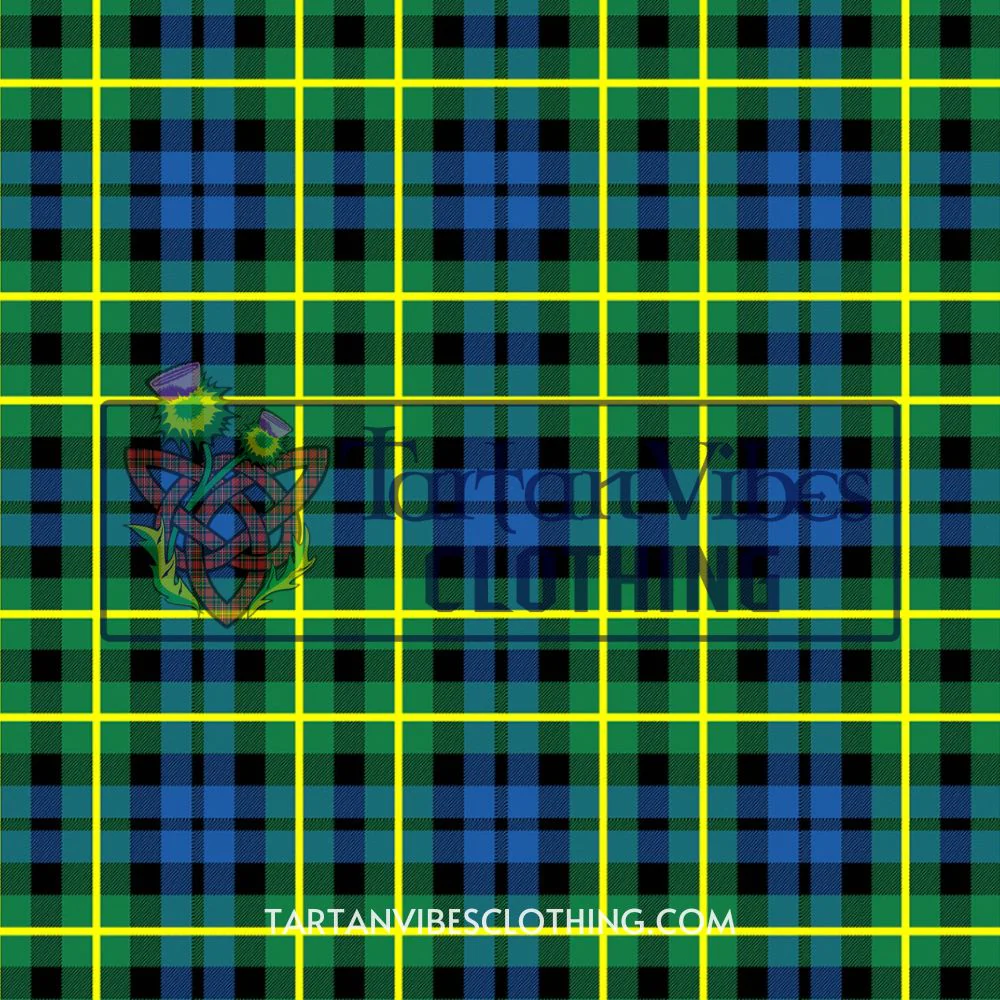
Explore the timeless traditions of the Clan Campbell of Breadalbane Tartan through our collection of tartan products on our website. And bring a piece of the clan's history into your present. 🔥
Campbell of Cawdor Tartan
The Campbell of Cawdor Tartan is associated with the Cawdor branch of the Campbell clan, which initially bore the name Calder. This branch underwent a significant transformation when Lord John Campbell moved to England and altered the spelling to align with English pronunciation. The Cawdor tartan showcases a striking black, blue, white, and yellow blend, forming a unique and eye-catching pattern.
Historical Context: The Campbell of Cawdor Tartan is deeply rooted in the clan's history and is officially authorized by the present Clan Chief, Mac Cailein Mor. It traces its origins to the late 18th century, with its design evolving. Initially unnamed, it was christened as 'Campbell of Cawdor' in 1850, over a century after its inception.
Design Elements: The tartan features a striking combination of colors, with the addition of red and light blue stripes enhancing its visual appeal. This tartan is based on the Black Watch pattern, a military set that links it to the broader historical narrative of Scottish martial tradition.
Cultural Significance: The Campbell of Cawdor Tartan embodies the heritage of the Cawdor Campbells, reflecting their connection to Cawdor Castle—a historic landmark in the Highlands. This tartan symbolizes the branch's legacy and its contributions to Scottish history.




Explore the timeless traditions of the Clan Campbell of Cawdor Tartan through our collection of tartan products on our website. And bring a piece of the clan's history into your present. 🔥
Campbell of Loudoun Tartan
The Campbell of Loudoun Tartan is linked to the Loudoun branch of the Campbell Clan. It is renowned for its distinctive red and white stripes, often called Loudoun Red. This tartan's design is a testament to the adventurous spirit and pioneering nature of the Loudoun Campbells, who played a pivotal role in shaping the clan's legacy.

- Historical Background: The Loudoun Tartan shares similarities with the Black Watch tartan in terms of sett and color, closely resembling the Campbell of Breadalbane tartan but with the addition of both white and yellow stripes. It was first documented in the 1906 W & A K Johnston books and later acknowledged by the Mac Cailein Mòr, the Chief of the Clan Campbell.
Design and Characteristics: This tartan is celebrated for its bold and striking pattern, featuring vivid red and white stripes that stand out against the traditional Campbell palette. The design reflects the branch's distinctive contributions to the clan's history and unique cultural identity.
Cultural Importance: The Campbell of Loudoun Tartan remains one of the rarest Campbell tartans, symbolizing the unique heritage and pioneering spirit of the Loudoun Campbells. The tartan is also connected to the historic Loudoun Castle in Ayrshire, built for the 6th Countess of Loudoun in the early 19th century.
These variations highlight the diversity within the Campbell Clan and serve as a testament to the clan's enduring influence and legacy.
Clan Campbell Tartan Kilt
The kilt, an iconic garment of Scottish culture, has been closely associated with the Campbell Clan Tartan. The traditional Clan Campbell tartan kilt is a masterpiece of craftsmanship, meticulously crafted from the finest wool, showcasing the intricate pattern of the Campbell Clan Tartan. Traditionally, the kilt reaches just above the knees, allowing for ease of movement while maintaining a dignified appearance.
The traditional Campbell kilt is often adorned with a kilt pin, typically featuring the Clan Campbell crest. This emblem proudly declares clan affiliation and reinforces the wearer's connection to their heritage. The kilt is traditionally worn at formal occasions, clan gatherings, and celebrations, serving as a powerful symbol of identity and pride.
Modern variations of the Campbell Clan kilt have emerged, incorporating shorter lengths and contemporary design elements while still maintaining the essence of the traditional garment. These modern kilts allow individuals to express their connection to the clan more casually, making the Campbell Clan Tartan accessible to a broader audience.
Whether worn in its traditional form or as a modern adaptation, the Campbell Clan Tartan kilt remains a cherished garment. It celebrates the clan's rich heritage and fosters a sense of belonging among its wearers.

The Cultural Significance of Campbell Tartans
Role in Ceremonies and Festivals
The Campbell Clan Tartan is a powerful symbol of heritage and tradition that plays a central role in various ceremonies and festivals. At clan gatherings, weddings, and other significant events, the tartan is prominently displayed and often worn as kilts, sashes, or accessories. This practice reinforces a sense of unity and belonging among clan members, connecting them to their shared history.
During Highland games and other cultural festivals, the Campbell Clan Tartan is showcased with pride, highlighting the clan's enduring legacy and contributions to Scottish culture. These events allow Campbells worldwide to unite, celebrate their heritage, and honor their ancestors.
Modern Adaptations in Fashion
In contemporary fashion, the Campbell Tartan Fabric has found new life as designers incorporate its timeless patterns into various clothing and accessories. From kilts and scarves to ties and handbags, the tartan creates stylish and meaningful items that resonate with clan members and those who appreciate its historical significance.
The tartan's versatility and enduring appeal have made it popular for traditional and modern garments. Its distinctive patterns and rich colors inspire designers, ensuring that the Campbell Clan Tartan remains relevant and cherished in fashion.
Representation in Media and Popular Culture
Campbell Clan in Scotland
Geographic Influence and Historical Sites
The Campbell Clan's influence extended far and wide across Scotland, with their ancestral lands spanning the picturesque region of Argyllshire. This strategic stronghold provided the clan with both a natural defense and abundant resources, allowing them to establish their dominance and shape the history of Scotland.
Among the most significant landmarks associated with the Campbell Clan is Inveraray Castle, the ancestral seat of the Duke of Argyll. This grand estate is a testament to the clan's power and prestige. It offers a glimpse into the clan's rich history and architectural prowess. The castle, with its stunning gardens and opulent interiors, serves as a reminder of the Campbells' enduring legacy and contributions to Scottish culture.
Beyond Inveraray Castle, the Campbell Clan's influence can be seen in various historical sites throughout Scotland, from the rugged Highlands to the bustling Lowlands. The clan's strategic strongholds and historic landmarks tell the story of their ascent to power and impact on the Scottish landscape. These sites serve as cultural treasures, preserving the Campbell Clan's history and heritage for generations to come.

Contemporary Relevance
In modern times, the Campbell Clan upholds their rich heritage and contributes to Scottish culture through various initiatives. Their involvement in clan gatherings, historical reenactments, and educational programs underscores their commitment to preserving and celebrating their traditions.
Inveraray Castle is pivotal in these efforts. It serves as a cultural hub that welcomes visitors worldwide. The castle hosts events and activities that provide a deeper understanding of the Campbell Clan’s history and Scottish culture.
The clan’s dedication to heritage preservation extends globally. It connects with individuals of Scottish descent and fosters a sense of community among its descendants. Through organizations and associations focused on clan history, the Campbells preserve their traditions and values for future generations.
The ongoing relevance of the Campbell Clan highlights their enduring legacy and dedication to honoring their past. As they adapt to contemporary times, they remain committed to fostering pride and unity among their members, ensuring their historical contributions continue to be celebrated.
Conclusion
The Campbell Clan Tartan holds deep significance in Scottish culture and is a powerful symbol of clan identity. With its vibrant colors and intricate design, the tartan embodies the enduring spirit of the Campbells and their lasting legacy in Scotland and beyond. From historical battles to modern fashion, the Campbell tartan continues to weave into the fabric of Scottish heritage.
As a descendant of the Campbell clan or an enthusiast of Scottish culture, embracing and exploring the Campbell tartan and its rich history is a source of pride. Whether worn traditionally or incorporated into everyday style, the Campbell tartan remains a living testament to the clan's enduring legacy, connecting generations past and present.
Frequently Asked Questions
What is the most powerful Clan in Scotland?
Clan Campbell was one of the Highlands' largest and most powerful clans. Based primarily in Argyll, Clan Campbell's chiefs eventually became the Dukes of Argyll
What is the history behind the Campbell Clan Tartan?
The Campbell Clan Tartan has a rich history dating back to ancient Celtic traditions. Initially used for practical purposes like camouflage and identification, the tartan evolved into a symbol of the Campbell Clan's identity. Its design has undergone several transformations over centuries, reflecting changes in fashion, dyes, and weaving techniques. The tartan's association with the Black Watch regiment further highlights its historical significance in Scottish military heritage.
What are the key colors and elements of the Campbell Clan Tartan?
The Campbell Clan Tartan, often called the Campbell of Argyll Tartan, is known for its striking colors: deep green, blue, red, and white. Each color carries a symbolic meaning: green represents the lush Scottish Highlands, blue signifies loyalty, red symbolizes courage, and white stands for purity. These colors combine to form a symmetrical checkered pattern that embodies the clan's values and traditions.
Is Campbell tartan the same as a Black Watch?
The Black Watch is the same set as the Clan Campbell tartan but dyed in darker shades.
What are the different variations of Campbell Tartans?
There are several variations of Campbell Tartans, each associated with different clan branches. Notable examples include:
- Campbell of Argyll Tartan: Known for its bold colors and classic design.
- Campbell of Breadalbane Tartan: Features yellow accents and represents the Breadalbane branch.
- Campbell of Cawdor Tartan: Showcases a unique blend of black, blue, white, and yellow.
- Campbell of Loudoun Tartan: Distinguished by its red and white stripes, known as Loudoun Red.












